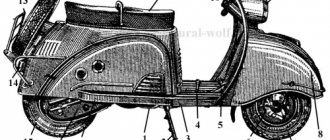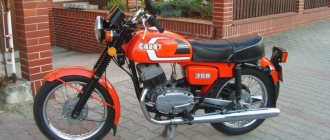The Electron scooter was developed in 1973 by the design bureau of a machine-building plant in the city of Vyatka. The task was set to create a lightweight two-wheeled vehicle for two people, economical and inexpensive. The predecessor and basis for the development was the Vyatka-150 model, which was produced since 1957 and was copied at one time from its Italian counterpart called Vespa. This prototype was used in many countries; the scooter was of the simplest design and very technologically advanced.
Technical characteristics of Vyatka VP 150
Common data:
Type - light road single; Base, mm - 1200; Ground clearance, mm - 160; Overall dimensions, mm: Length – 1825; Width – 800; Height -1150; Fuel tank capacity – 9-12 liters; Weight, kg: Dry – 110; Operational – 125; Fuel consumption rate on the highway, l/100km – 3.2; Fuel range on the highway, km – 350; Maximum speed, km/h; - 70; Main capacities, l: Gearbox housing – 0.130; Front fork vibration damper – 0.50; Rear suspension – 0.1;
Engine
Type – Single-cylinder two-stroke with return two-channel purging and forced air cooling; Cylinder diameter, mm – 57; Piston stroke, mm – 58; Working volume, cm cubed – 148; Maximum power l. With. – 4.5; Compression ratio – 6.5; Number of sealing piston rings – 2; Material: cylinder head – aluminum alloy; head gaskets – reinforced asbestos; pistons – aluminum alloy; Piston pin diameter, mm – 15; Valve timing: opening of the intake window - 71 degrees b.c.t. Closing – 71 degrees after b.t.t. opening of the outlet window - 68 degrees BC. closing - 68 degrees after BC. opening of purge windows - 59 degrees BC. closing - 59 degrees after ground mt.
Supply system
Carburetor - one K-55; Diffuser diameter, mm – 20; The fuel filter is a mesh filter in the sump.
Power transmission
Forward gear – gear 304; Clutch - multi-plate operating in an oil bath; Number of disks: leading – 3; slaves – 3; Gearbox – three-speed; Gear shift control – manually by turning the left steering wheel; Gear ratio: first gear – 4.833 – second – 2.888; — third – 1,800; Overall gear ratio: In first gear - 14.7; v - second - 8.8; — third – 5.5;
Ignition and electrical equipment
Ignition type – from alternator; Ignition coil – B-50; Breaker – mounted on the generator stator; Battery – 3-MT-7;v Voltage, V – 6;v Glow plug – A11U; Relay regulator – selenium rectifier; v Signal – S-34; Headlight – FG-50V; Ignition timing is 29 degrees plus or minus one degree before T.M.T. Ignition timing adjustment is constant, adjustable during installation; Gaps, mm: Between breaker contacts – 0.3 – 0.4; — spark plug electrodes – 0.5 – 0.6;
Chassis
Frame – tubular welded; The front and rear wheel suspension is of the lever type with springs and a hydraulic vibration damper; Brakes - shoe; Wheels – disc collapsible interchangeable (on discs); Tire size, in inches – 4.00 – 10; Air pressure in tires (first number without a passenger), atm: Front wheel – 1 atm, 1.2 atm; Rear wheel – 1.5 atm, 2.5 atm.
Return to contents — ↑
Motor scooter Vyatka VP-150
The VP-150 scooter is equipped with a single-cylinder two-stroke engine with crank-chamber purging and forced air cooling with a power of 4.5 liters. With.
Cylinder 6 is cast from fine-grained cast iron and has one inlet, two bypass and one outlet channels. These channels inside the cylinder end with windows, and outside with pipes for connecting the K-55 carburetor and exhaust pipeline.
The cylinder head 2 is cast from an aluminum alloy and has a spherical combustion chamber and a hole for screwing in a spark plug 22. The casing 1 directs the flow of cooling air from the fan 7 to the finned surfaces of the cylinder and cylinder head.
Piston 4 is cast from aluminum alloy; its bottom has a figured shape, which helps to improve the process of purging the cylinder with air. In the upper part of the piston there are two grooves for installing sealing rings 3. The upper piston ring is chrome plated. Piston pin 5 is steel. It is secured in the piston bosses with retaining rings 21.
Connecting rod 20 is stamped from steel. A bronze bushing is pressed into the upper head of the connecting rod, and a roller bearing 18 is installed in the lower head, which is secured with two washers with spring rings. The bearing is lubricated through two slots milled in the lower head of the connecting rod.
The crankshaft rotates on two bearings 11.
Lubrication of the Vyatka VP-150 scooter engine is carried out by supplying oil to all rubbing parts along with a combustible mixture. To do this, oil is added to gasoline when refueling. For a non-run-in engine, 1 liter of oil is added for every 20 liters of gasoline, and for a run-in engine, 1 liter of oil is mixed with 25 liters of gasoline.
Return to contents — ↑
Fall in demand
However, on the whole, an unhappy fate awaited an otherwise good car in the near future. By the end of the seventies, the popularity of the scooter began to decline. This is primarily due to the increased opportunities for the population to purchase cars. In addition, many preferred to buy motorcycles as a more suitable form of transport, while scooters were not off-road and would get stuck on a washed-out road. They couldn’t pass where a motorcycle could easily pass. The speed characteristics of the Electron also did not stand up to comparison.
Among other things, deliveries of Czechoslovak Java motorcycles began to the USSR: the single-cylinder Java-250 model and the two-cylinder Java-350 with a sidecar. The beautiful, cherry-colored car immediately conquered the market throughout the Soviet Union. Young people dreamed of purchasing a prestigious motorcycle, but they simply forgot about the Electron scooter.
In a short time, all Sporttorg bases were overstocked with unsold scooters; one after another, the stores refused to supply them. And, as a consequence of this, the management of the Vyatsko-Polyansky plant was forced to stop production of the Electron, so the history of the Vyatka scooters ended there. Only many years later, after the collapse of the USSR, the plant managed to start producing a scooter called “Strizh” - a copy of the German “Zimzon”.
Engine power supply system for Vyatka VP 150 scooter
The power system of the Vyatka VP-150 scooter consists of a fuel tank with a capacity of 12 liters, a K-55 carburetor, a fuel tap, connecting fuel hoses and an air cleaner.
The K-55 carburetor is secured to the inlet pipe of the cylinder using a clamp 9. Fuel enters the float chamber 13 through the fitting 10 and the shut-off needle 14, which is connected to the float 15 using a spring lock. From the float chamber, gasoline flows through channel 16 to the nozzle P and then to the sprayer 7, which includes a needle 19. The needle is connected to throttle valve 5 via lock 20.
The throttle valve moves up using a cable, and lowers using the force of spring 4, which is compressed when the valve rises. Screw 18 is designed to adjust the carburetor to low engine speeds at idle.
To adjust the carburetor, depending on operating conditions, change the position of the needle in the throttle valve. The position of the needle is fixed using lock washer 20. In the housing cover 3, the carburetor control cable is adjusted using the cable sheath stop 1 and the control nut 2.
Return to contents — ↑
Production development
The improved transmission became the main argument in favor of the exclusivity of the Vyatka-150VP. The modified model could already be exported without fear of receiving claims from the Italians regarding copyright infringement. The new model was launched into production in 1967, on the occasion of the fiftieth anniversary of the October Revolution, and the previous “Vyatka” was discontinued at the same time.
Power transmission of the Vyatka VP-150 scooter
The VP-150 scooter uses a multi-disc clutch operating in an oil bath. The clutch is installed on the engine crankshaft in the forward gearbox.
The clutch consists of four driving steel discs 4, a driving drum 1, three driven steel discs 3 with cork inserts, six pressure springs 10, a drive gear 8 (clutch driven drum) and a release mechanism.
The drive gear, on which the driven disks are located, rotates on a needle bearing 6. The axial movement of the gear is fixed by a support washer 7.
The release mechanism consists of a stop 11 with a lock 12, a rod 13, a lever 14 and a roller 15, which is rotated using a cable connected to the clutch release lever; The lever is located on the left half of the steering wheel.
A three-speed gearbox with constant mesh gears and keyed gear shifting is mounted on the VP-150 scooter in the engine.
The gearbox consists of an axis 4 of the gear block of the secondary shaft 20, a gear block 2, three driven gears 16, 17 and 18 and a gear shift mechanism.
The gear block 2 rests on the ball 1 and needle bearing 3 and receives rotation from the first gear. The secondary shaft rests on two ball bearings 19 and 23 and one bronze plain bearing. One end of the secondary shaft has four through grooves, inside of which there is a movable key 15.
When the lever 10 of the gear shift mechanism rotates, the shift rod 11 and the key move, the protrusions of which, entering one or another groove of the driven gears, engage one of the gears.
The trigger mechanism operates by pressing the start pedal 9, while the housing 8 of the trigger mechanism rotates and drives the ratchet 6 until it engages with the teeth of the first gear gear. As the trigger mechanism is turned further, the first gear gear, gear block and engine crankshaft begin to rotate. Spring 7 returns the trigger housing to its original position, and the teeth of the ratchet disengage with the teeth of the first gear gear.
The transmission of torque from the engine crankshaft through the clutch to the gearbox on the VP-150 scooter is carried out by a front gear consisting of a pair of cylindrical gears with oblique teeth. The forward gear is retarded, which provides a constant increase in torque.
The transmission of motion from the gearbox to the drive wheel occurs directly through the output shaft of the gearbox.
Return to contents — ↑
Three-wheeled modifications
In the fall of 1959, at the exhibition “Motor scooters and motorcycles”, held at the Moscow Polytechnic Museum, various three-wheeled versions of the “Vyatka” were presented. The engine on all models was located in the middle, rotation was transmitted to the rear wheels through a bevel differential, and then to the rear drive wheels.
The Vyatka scooter in this version was widely used in the field of grocery delivery around the city. A total of three variants were produced: the MG-150F model, with a closed body, the MG-150 with an open platform, and the MG-150S with a dump body. All modifications had a carrying capacity of 250 kilograms. The speed of movement did not exceed 35 km/h.
Electrical equipment of the Vyatka VP 150 scooter
The electrical equipment system of the Vyatka VP-150 scooter includes a Z-MT-7 battery, a flywheel alternator, a generator rectifier and stabilizer, ignition, lighting and alarm system devices.
Return to contents — ↑
Generator and principle of its operation
A flywheel alternator (magdino) combines a magneto and a generator. The generator recharges the battery and supplies current to the primary winding of the ignition coil. The charging current passes through a selenium rectifier installed in a common housing with a voltage stabilizer.
The generator rotor is rigidly fixed to the engine crankshaft and rotates with it as one unit.
The stator is attached to the engine crankcase. When the flywheel rotates, the poles of the permanent magnets alternately approach the cores of the stator coils, as a result of which an alternating current is induced in them.
The rectifier circuit includes a ballast resistance of 1.3 ohms, which limits the charging current of the battery, thereby achieving normal charging mode without the use of a voltage regulator.
Return to contents — ↑
Voltage regulator
Voltage stabilizer for the Vyatka VP-150 scooter: 1 – terminal to the battery; 2 – selenium column element; 3 – resistance; 4 – primary winding; 5 – transformer; 6 – secondary winding; 7 – resistance; 8 – capacitor.
The voltage stabilizer is designed to maintain voltage in the electrical circuit in accordance with the engine speed. The stabilizer consists of a transformer 5 with a primary 4 and secondary 6 windings, a capacitor 8 and an additional resistance 7 (1.4 ohms).
Return to contents — ↑
Ignition system devices
Vyatka VP-150 scooter breaker: 1 – lever cushion; 2- base; 3 – stand; 4 – moving contact; 5 – fixed contact; 6 – lever; 7 – capacitor; 8 – filter; 9 – spring; 10 – wire to the generator coil; 11 – wire to ignition coil; 12 – wire to the ignition off button.
Battery ignition devices include a B-50 ignition coil, a breaker, a capacitor, a spark plug, an ignition switch, and low and high voltage wires. The breaker is mounted on the generator stator and is located under the flywheel. The VP-150 scooter engine uses an A11U spark plug, the gap between the electrodes of which should be 0.6-0.7 mm. The scooter is equipped with an FG-50 headlight, consisting of a housing, a reflector with a rotating mechanism and electric lamps. The S-34 signal provides 275-300 membrane vibrations per second.
Return to contents — ↑
Central switch
Diagram of the central switch of the Vyatka VP-150 scooter: 1 – fixed contact; 2 – slider; 3 – base; 4 – switch lever.
On the right side of the steering wheel there is a central switch for lighting, alarm and ignition systems. The switch consists of five fixed contacts 1 and a slider 2 with a lever 4. Using the switch you can provide: C - turning on the parking light lamps; O - turn off the lighting; B — turning on the low beam; D — turning on the high beam. On the left side of the switch there is a button to turn off the ignition, and on the right side there is a horn button.
Return to contents — ↑
General diagram of electrical equipment
Electrical diagram of the Vyatka VP-150 scooter: 1 – generator base; 2 and 3 – induction coils of devices; 4 – breaker; 5 – induction coil of the ignition system; 6 – battery; 7, 8 and 15 – transition panels; 9 – voltage stabilizer; 10 – signal; 11 – headlight; 12 – central switch; 13 – signal button; 14 – ignition key; 16 – ignition coil; 17 – high voltage wire; 18 – candle; 19 – rear light
Return to contents — ↑
Appearance
The USSR economy was gradually recovering after the war, and by the mid-50s, the leadership was faced with the question of providing the market with easy-to-use and affordable vehicles. The order for the development of scooters from the USSR Ministry of Defense Industry was issued in 1956. A small amount of time was allocated to create the vehicle - only six months - after which the scooter was supposed to go into mass production. That is why the designers decided to take the Vespa 150GS scooter, released in 1955 in Italy, as a basis. Already in the fall of 1956, the first samples were ready, and the following year the production of the VP-150 “Vyatka” was fully established.










